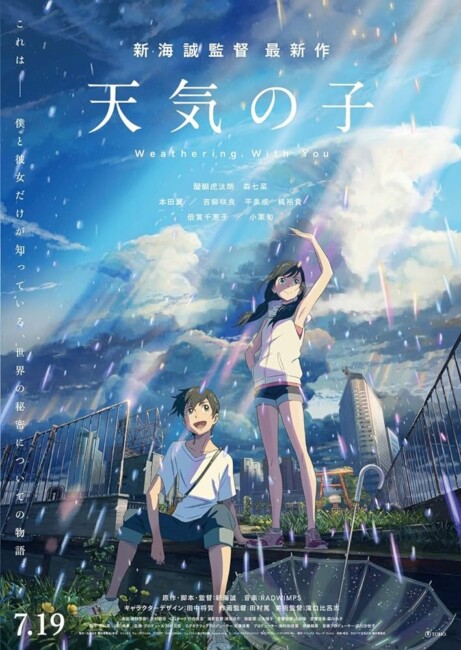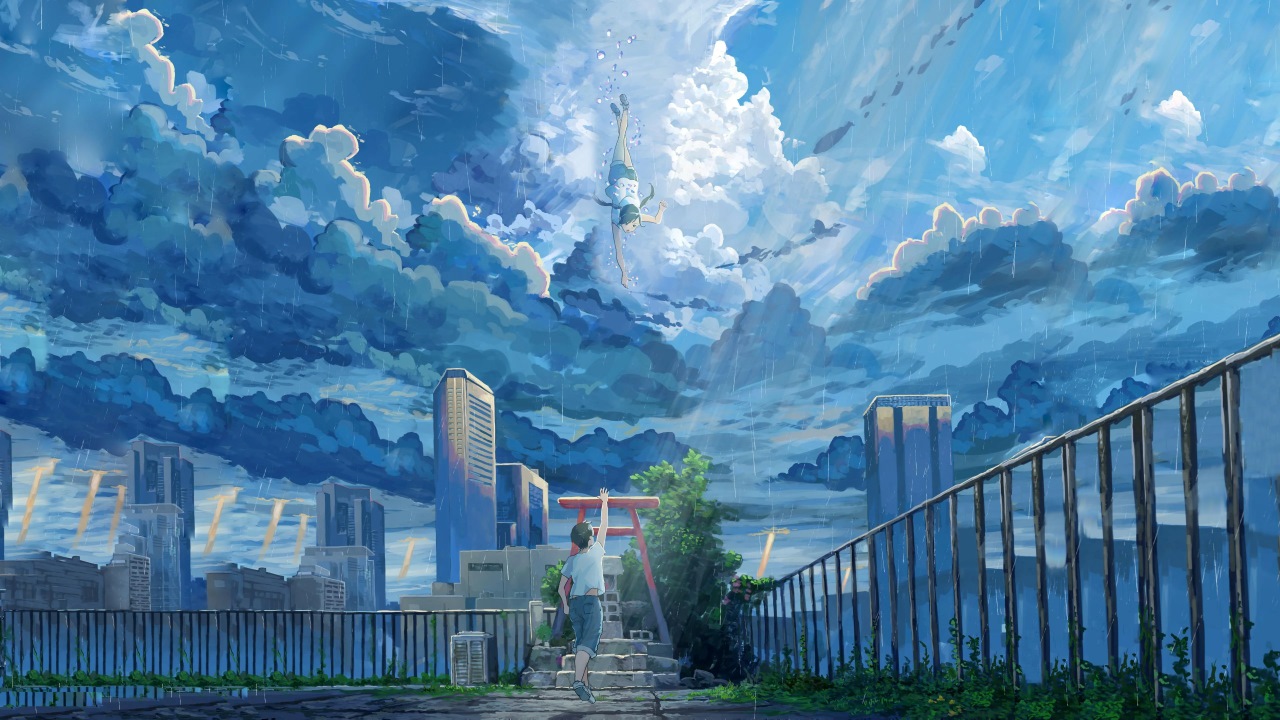(Teriki no Ko)
Crew
Director/Screenplay – Makoto Shinkai, Producers – Kinue Ito & Wakana Okamura, Photography – Ryosuke Tsuda, Music – Radwimps, Art Direction – Hiroshi Takaguchi. Production Company – CoMix Wave Films/Story Inc/Toho/Kadokawa.
The Science Fiction Horror and Fantasy Film Review

Director/Screenplay – Makoto Shinkai, Producers – Kinue Ito & Wakana Okamura, Photography – Ryosuke Tsuda, Music – Radwimps, Art Direction – Hiroshi Takaguchi. Production Company – CoMix Wave Films/Story Inc/Toho/Kadokawa.
Hodaka Morishima has run away from home and arrives in Tokyo. He is immediately overwhelmed trying to find shelter and dealing with the exorbitant cost of living. At the same time, his young age acts against him in trying to find work. In a McDonalds, Hina Amarino takes pity on him and gives him some food. Hodaka calls Keisuke Suga, whom he met on the ferry. Keisuke offers Hodaka food and shelter in return for help on the magazine about unexplained phenomena he produces. Hodoka works alongside Natsumi, who he initially believes to be Suga’s mistress before finding she is his niece. Hodoka later comes across Hina being forcibly dragged away by a club owner and pulls a gun he has found to save her. The two fall in together where she demonstrates the ability to pray and cause the rain to clear. Hodaka suggests that they go into business. He creates a website where she advertises herself as a Sunshine Girl, clearing the weather for those who need it. As Natsumi writes an article on the mystery sunshine girl, she uncovers the truth – that Hina is a hereditary priestess and must sacrifice her life in order to clear the unseasonal rains that are drowning Tokyo. Meanwhile, the police are searching for Hodaka because of his possession of the gun.
Makoto Shinkai is a name that has been gaining growing acclaim in Anime. Shinkai’s first work was the 25-minute long Voices of a Distant Star (2002) about interstellar email communication, followed by the feature-length The Place Promised in Our Early Days (2004) set in an alternate world Japan and 5 Centimetres Per Second (2007) about a friendship between two people over the years. Shinkai’s name started to be noticed with Children Who Chase Lost Voices from the Deep (2011), followed by the non-genre The Garden of Words (2013), the wide acclaim of Your Name. (2016) and Weathering With You, and subsequently the portal fantasy Suzume (2022).
At face value, Weathering With You looks like a “huh?” movie – a teen romance involving a girl who can control the weather seems a lame premise. However, I was prepared to give the film quite a bit of rope because anime has a habit of taking weird premises and making them work – remember the idea of an afterlife bathhouse in Spirited Away (2001) or a talking pig aviator in Porco Rosso (1992), and more recent offerings such as Lu Over the Wall (2017) about a mermaid who grows legs and joins a pop band or Drifting Home (2022) where an abandoned apartment building drifts away to sea. And then well there was the name of Makoto Shinkai that makes a project worth seeing no matter what it was.
Weathering With You is immediately captivating. Makoto Shinkai does a beautiful job of capturing Tokyo right down to granular detail, seeing the brand names in the background, giving us animated snapshots of real train stations and suburbs. And in the midst of this, he casts the character of Hodaka as a runaway. Shinkai attains a great sense of alienation and aloneness simply by showing Hodaka economically disadvantaged amid the city’s insanely hiked prices.

The meeting of the two central characters occurs at a genteel unhurried pace. Makoto Shinkai just enjoys a leisurely stroll through the plot, taking in the appealingly off-kilter figures around the edge of the show. There isn’t too much drama until the authorities arrive to split the characters apart in the last third of the show and of Hodaka’s titanic struggle to find Hina again.
My feeling is also that Weathering With You falters when it comes to the climactic scenes. Shinkai introduces the mythology of the community shaman who has to sacrifice their life. This needed more establishing than it gets, especially when Hina is taken up into the clouds for … reasons and then Hodaka must go on a titanic journey to rescue her that involves them falling to the ground from the clouds. You get the general idea of what is occurring, but the feeling is that these places – the world in the clouds, not to mention the creatures that seem to live there and why some people are chosen – needed more than the intriguing hints of a greater mythology that we are given.
Anime characteristically involves climaxes that reach an apotheosis where sacrifice heals the environment/world – see films like Nausicaa and the Valley of the Wind (1984), Princess Mononoke (1997), Final Fantasy: The Spirits Within (2001), the aforementioned Lu. Weathering With You is notable for going in exactly the opposite direction, reaching a climax where the heroine sacrifices herself to save the city only for the young hero to go on an epic quest to rescue her, before an ending that reaches a shrug of the shoulders and goes “the heck with saving Tokyo, the city has always been buried under water anyway, let it drown again.”
Trailer here